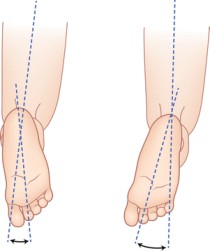Special test for the Tibial Torsion
- These tests are applied by to therapist or doctor in the clinic to check the tibial torsion of the ankle.
- When testing for tibial torsion, the examiner must realize that some lateral tibial torsion [ 13′ to 18′ in adults, less in children ] is normally present.
- If tibial torsion is more than 18′, it is referred to as a toe-out position.
- If tibial torsion is less than 13′, it is referred to as a toe-in position.
- Excessive toeing – is sometimes referred to as pigeon toes & may be caused by medial tibial torsion, medial femoral torsion,/ excessive femoral ante version.
Name of the special test of tibial torsion:
- Tibial torsion test in the prone position
- Tibial torsion test in the supine position
- Tibial torsion test in sitting position
- Too many toes sign
Purpose of the special tests :
- These tests are used to check the tibial torsion of the leg.
- It is also checked the toe position.
Tibial torsion test in the prone position:
- The patient is in the prone position with the knee flexed up to 90′.
- The examiner views from above the angle formed by the foot & thigh after the subtalar joint has been placed in the neutral position, noting the angle the foot makes with the tibia.
- This prone position of tibial torsion is most often used in children because it is easier to observe the feet from above.
Tibial torsion test in the supine position
- The patient lies supine.
- The examination ensures that the femoral condyle lies in the frontal plane means patella facing straight up.
- The examiner palpates the apex of both malleoli with one hand & draws a line on the heel representing a line joining the two a pices.
- The examiner is drawn to a second line on the heel which is parallel to the floor.
- The angle which is drawn by to therapist is formed by the intersection of the two lines which indicate the amount of lateral tibial torsion.


Tibial torsion test in sitting position
- Tibial torsion is measured by having the patient sit with the knee flexed to 90’over the edge of the examining table.
- The examiner has put the thumb of one hand over the apex of the one malleolus.
- Next, the examiner visualizes the axes of the knee & of the ankle.
- The lines are not normally parallel but instead from an angle of 12′ to 18′ owing to lateral rotation of the tibia.

Too many toes sign

- The patient stands in a normal relaxed position while the examiner views the patient from behind.
- If the heel is in valgus, the forefoot abducted,/ the tibia laterally rotated more than normal means tibial torsion, the examiner can see more toes on the affected side than on the normal side.
- Similarly, lateral femoral torsion could cause too many toes test is positive.
- If the talus is positioned in neutral & the calcaneus is in neutral, the too many toes sign means the forefoot is adducted on the rear foot & may be seen with excessive pronation [ hyper pronation].
- Hyper pronation is often associated with metatarsalgia, plantar fasciitis, hallux valgus & posterior tibial tendon pathology.
FAQs
What is the tibial torsion test?
The angle between the axis of the foot and the axis of the thigh is measured with the child prone and the knees flexed to 90° in order to assess for tibial torsion. The foot axis is about 10° lateral to the thigh axis.
How do you measure tibial torsion?
The most frequent technique for determining tibial torsion is to measure the angle created by the proximal and distal articular axes of the tibia in transverse computerized tomograms, which is regarded as the “golden standard” for determining tibial torsion.
How do you test for tibial torsion in the ankle?
Thigh-foot angle (TFA)
The patient is positioned in a prone position with their knees flexed to 90 degrees in order to evaluate internal or external tibial torsion. A thigh-foot-ankle (TFA) measurement is made between a line crossing through the back of the thigh and another line crossing through the foot.
How do you know if you have tibial torsion?
The most obvious sign of internal tibial torsion is intoeing. When a child walks or stands, it indicates that the feet are obviously inclined toward one another. The hip bone’s femoral anteversion and the foot’s metatarsus adductus are two other common reasons of intoeing.
What is a normal tibial torsion?
The lateral rotation of the tibia typically grows from around 5° at birth to about 15° at maturity. The natural path is towards increased external torsion, although medial torsion becomes better with time, lateral torsion frequently gets worse.







